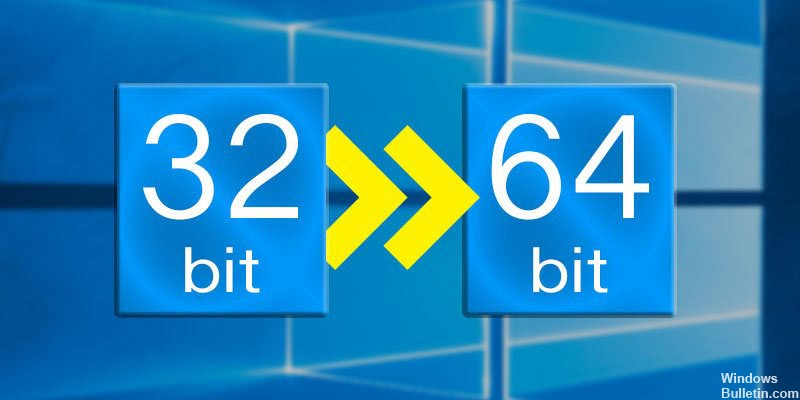

- #IS BETTER TO RUNNING 32 BIT ON 64 BIT PROGRAMS UPGRADE#
- #IS BETTER TO RUNNING 32 BIT ON 64 BIT PROGRAMS FULL#
- #IS BETTER TO RUNNING 32 BIT ON 64 BIT PROGRAMS FOR WINDOWS 10#
- #IS BETTER TO RUNNING 32 BIT ON 64 BIT PROGRAMS SOFTWARE#
- #IS BETTER TO RUNNING 32 BIT ON 64 BIT PROGRAMS CODE#
If you have two versions then you have double the testing, and properly testing software across a range of OS versions and languages is not a quick process. However if you do need your software to run on older OSes then you may actively NOT want to provide a 64-bit version. Just stick to 64-bit, specify that it requires a 64-bit OS, and job done. If you don't need your software to run on older OSes, you may not need to provide a 32-bit version. If your software is a standalone executable, it's less clear.

You have no idea whether the customer will be using 32-bit or 64-bit software to talk to the DLL, and the DLL has to use the same bit-length as the application. If your software is a DLL, you MUST provide both 32-bit and 64-bit versions.
#IS BETTER TO RUNNING 32 BIT ON 64 BIT PROGRAMS CODE#
This was done precisely because the performance overhead I mentioned above was causing real measurable, quantifiable problems for real-world users running real-world code in real-world systems. Linux recently added the x32 ABI, which allows you to run AMD64 code with 32 bit pointers, so even though that's not a "proper" CPU architecture, it is a way of using the AMD64 architecture in such a way as if it had a native 32 bit variant. The most well-known are IA64, which is only 64 bit and has no 32 bit variant, and x86/AMD64 which are, albeit closely related, different architectures, x86 being 32 bit only, AMD64 being 64 bit only.Īctually, that latter statement is not 100% true anymore. In that case, the question obviously doesn't make sense. Note: there are some architectures where there are no corresponding 32 or 64 bit variants. If one or both of those is true, it makes sense to use 64 bit software, otherwise it doesn't. Basically, there are two ways to do this: you do a lot of 64 bit integer math, or you need more than 4 GiByte mapped memory. This has a non-negligible negative effect on performance.ĭoing this only makes sense if you can "buy back" those performance costs somehow. you have effectively lowered the size of the instruction cache by ~20%.you have effectively lowered your memory bandwidth (for object code) by ~20%.your object code will take up ~30% more space in memory.your object code will take ~30% longer to load from disk into RAM.This typically works out to about a 30% increase in object code size. And (at least on an ILP32/LP64 architecture) your longs are twice the size as well. That means all pointers in your program are twice the size. The difference between 32 bit software and 64 bit software is the size of the pointers, and maybe the size of the integer registers. Unless comparing a very specific CPU architecture, operating system and library infrastructure here, I won't be able to go into more details. Certain techniques like ASLR and others depending on a much larger address space than physical memory won't work well (or at all) in a 32-bit execution mode.The 64-bit CPU architecture may not even support 32-bit at all.Beware of different default widths for integer datatypes, additional testing needed.Only user-space libraries should differ between 32-bit and 64-bit, not the API of kernel modules. No difference at all if you are linking statically. If a 32-bit version of a shared library is loaded exclusively for your application, and that counts towards your footprint. May require 32-bit versions of all (most Linux distributions) or uncommon (most Windows versions) libraries and run time environments.This is highly compiler and CPU specific. Not using additional registers and instruction set extensions depending on 圆4.
#IS BETTER TO RUNNING 32 BIT ON 64 BIT PROGRAMS FULL#
(Just per process, in sum multiple 32-bit processes may use the full available system memory.) 2 GB, 3 GB, or 4 GB memory limit per process.Memory leaks are hard capped to 2 GB, 3 GB, or 4 GB and won't swamp the entire system.ĭrawbacks of 32-bit software in 64-bit environments.Compatibility with 32-bit environments.Lower memory footprint, especially in pointer-heavy applications, 64-bit vs 32-bit can easily double the memory requirements.Then choose which OS version to run it in compatibility mode for.Benefits of 32-bit software in 64-bit environments Then check the box next to “Run this program in compatibility mode for:”. Then right click the program, then click properties then go to the compatibility tab. If it is a shortcut you can right click and choose “open file location”.
#IS BETTER TO RUNNING 32 BIT ON 64 BIT PROGRAMS UPGRADE#
How do I upgrade Chrome 32-bit to 64-bit?.How can I change 32-bit to 64-bit without formatting?.How do I change my bios from 32-bit to 64-bit?.

#IS BETTER TO RUNNING 32 BIT ON 64 BIT PROGRAMS FOR WINDOWS 10#


 0 kommentar(er)
0 kommentar(er)
